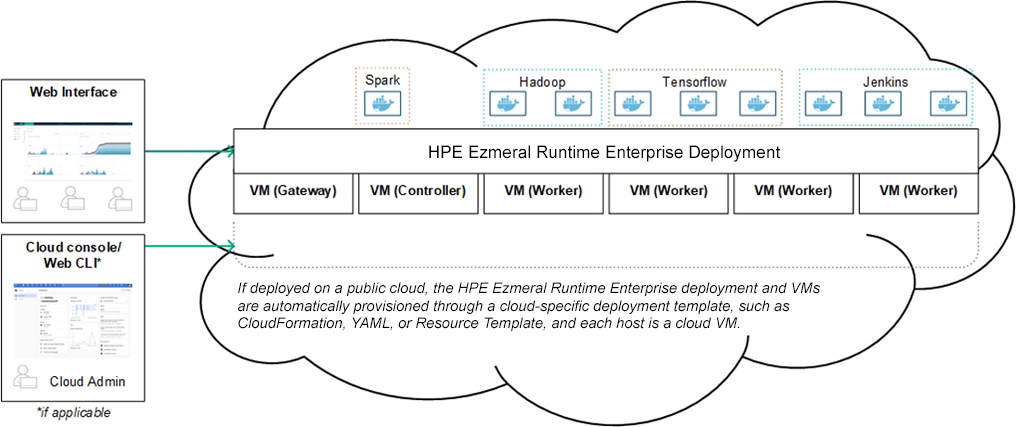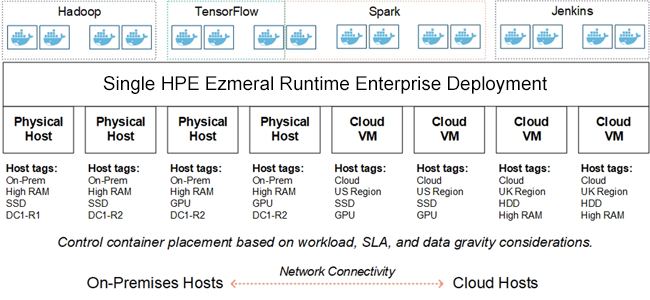On-Premises, Hybrid, and Multi-Cloud Deployments
HPE Ezmeral Runtime Enterprise can be deployed standalone on-premises and/or on a public cloud, as well as in a hybrid deployment where some of the hosts reside on-premises (including in multiple data centers) while other hosts reside on one or more public clouds. In each case, the network requirements described in Networks and Subnets must be satisfied. HPE Ezmeral Runtime Enterprise supports all of the major cloud providers:
- Amazon Web Services (AWS): Either a configurable AWS CloudFormation or a
purpose-built
cepicctlcommand line tool can be used to configure HPE Ezmeral Runtime Enterprise on EC2 instances.EC2 instances that contain NVMe SSDs are not supported in HPE Ezmeral Runtime Enterprise 5.3.1. However, EC2 instances that contain NVMe SSDs are supported in HPE Ezmeral Runtime Enterprise 5.3.5 and later releases.
- Google Cloud Platform (GCP): A configurable YAML deployment script in
conjunction with the
glclouddeployment tool is used to configure HPE Ezmeral Runtime Enterprise on Google Cloud compute instances (VMs). - Microsoft Azure: A configurable Azure Resource Manager template is used to configure HPE Ezmeral Runtime Enterprise on Azure instances.
Benefits
HPE Ezmeral Runtime Enterprise offers the following benefits regardless of the deployment model used:
- The same general approach may be used to install and run HPE Ezmeral Runtime Enterprise regardless of how it is deployed. See Deployment Models.
- The code base and management experience are identical for a fully on-premises deployment, fully cloud-only deployment, or hybrid deployment.
- You retain complete control over your on-premises and/or cloud infrastructure. For example, you can leverage your existing application machine images (e.g. AWS AMI) for your certified RHEL operating system as well as any cloud specific features like disaster recovery. You may leverage cloud-specific features for the hosts in your deployment, such as availability zones, spanning hosts across subnets, and instance types when using virtual machines as hosts.
- HPE Ezmeral Runtime Enterprise supports vCPU over-provisioning and can place multiple virtual nodes/containers on each host, thereby increasing host utilization and reducing costs.
- HPE Ezmeral Runtime Enterprise supports host tags that can be used to control the placement of virtual nodes/containers among on-premises hosts and/or cloud instances from AWS, Azure or GCP. This enables the placement of virtual nodes/containers based on workload (e.g. Spark, TensorFlow etc), SLA and data gravity considerations. See About Tags.
- HPE Ezmeral Runtime Enterprise provides common benefits regardless of the deployment model used (see Deployment Models), including strict tenant isolation without cloud-specific networking constructs.
- Gateway hosts use HAProxy to control access (ingress) to application service endpoints. See Gateway Hosts.
Deployment Models
As described above, HPE Ezmeral Runtime Enterprise may be deployed as follows:
- Entirely on-premises or on a single public cloud: See Single Cloud.
- Across on-premises and one or more public clouds: See Hybrid and Multi-Cloud.
Single Cloud
This diagram depicts a deployment that has been installed either on a single public cloud or on-premises on virtual machines in a private cloud.

Hybrid and Multi-Cloud
This diagram depicts a deployment that has been installed across one or more public clouds and physical hosts on-premises.
